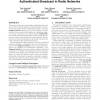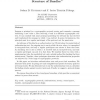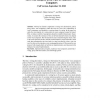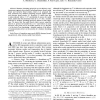285 search results - page 37 / 57 » Computationally Sound, Automated Proofs for Security Protoco... |
LICS
2003
IEEE
14 years 26 days ago
2003
IEEE
We provide a method for deciding the insecurity of cryptographic protocols in presence of the standard Dolev-Yao intruder (with a finite number of sessions) extended with so-call...
SPAA
2010
ACM
14 years 12 days ago
2010
ACM
This paper studies non-cryptographic authenticated broadcast in radio networks subject to malicious failures. We introduce two protocols that address this problem. The first, Nei...
TCS
2002
13 years 7 months ago
2002
Suppose a principal in a cryptographic protocol creates and transmits a message containing a new value v, later receiving v back in a different cryptographic context. It can concl...
ESORICS
2010
Springer
13 years 8 months ago
2010
Springer
Norway has started to implement e-voting (over the Internet, and by using voters' own computers) within the next few years. The vulnerability of voter's computers was ide...
Publication
Distance bounding protocols are an effective countermeasure against relay attacks including distance fraud, mafia fraud and terrorist fraud attacks. Reid et al. proposed the first ...




